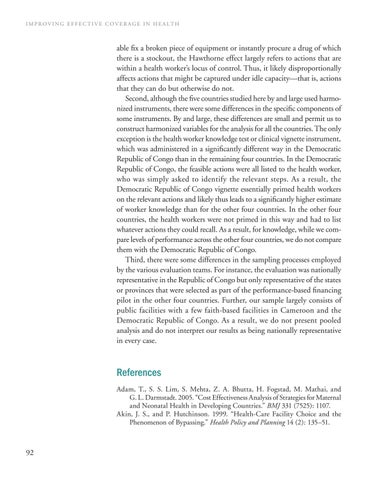IMPROVING EFFECTIVE COVERAGE IN HEALTH
able fix a broken piece of equipment or instantly procure a drug of which there is a stockout, the Hawthorne effect largely refers to actions that are within a health worker’s locus of control. Thus, it likely disproportionally affects actions that might be captured under idle capacity—that is, actions that they can do but otherwise do not. Second, although the five countries studied here by and large used harmonized instruments, there were some differences in the specific components of some instruments. By and large, these differences are small and permit us to construct harmonized variables for the analysis for all the countries. The only exception is the health worker knowledge test or clinical vignette instrument, which was administered in a significantly different way in the Democratic Republic of Congo than in the remaining four countries. In the Democratic Republic of Congo, the feasible actions were all listed to the health worker, who was simply asked to identify the relevant steps. As a result, the Democratic Republic of Congo vignette essentially primed health workers on the relevant actions and likely thus leads to a significantly higher estimate of worker knowledge than for the other four countries. In the other four countries, the health workers were not primed in this way and had to list whatever actions they could recall. As a result, for knowledge, while we compare levels of performance across the other four countries, we do not compare them with the Democratic Republic of Congo. Third, there were some differences in the sampling processes employed by the various evaluation teams. For instance, the evaluation was nationally representative in the Republic of Congo but only representative of the states or provinces that were selected as part of the performance-based financing pilot in the other four countries. Further, our sample largely consists of public facilities with a few faith-based facilities in Cameroon and the Democratic Republic of Congo. As a result, we do not present pooled analysis and do not interpret our results as being nationally representative in every case.
References Adam, T., S. S. Lim, S. Mehta, Z. A. Bhutta, H. Fogstad, M. Mathai, and G. L. Darmstadt. 2005. “Cost Effectiveness Analysis of Strategies for Maternal and Neonatal Health in Developing Countries.” BMJ 331 (7525): 1107. Akin, J. S., and P. Hutchinson. 1999. “Health-Care Facility Choice and the Phenomenon of Bypassing.” Health Policy and Planning 14 (2): 135–51.
92

